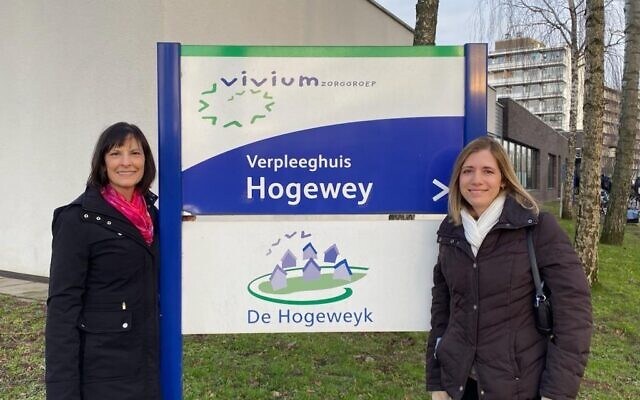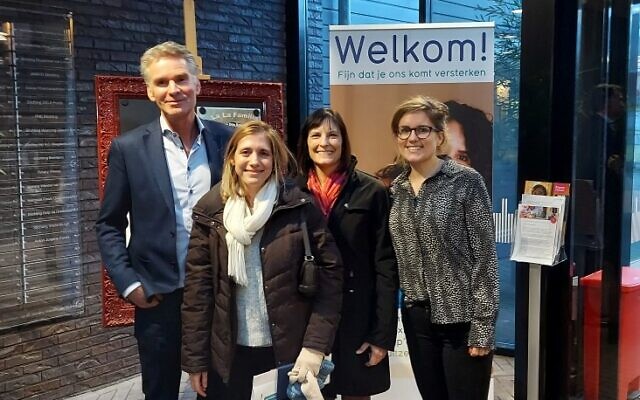JF&CS Aging Specialists Bring Netherlands’ Lessons
Deborah Zisholtz and Georgia Gunter traveled to The Netherlands to learn about the latest in caring for adults with dementia.

Deborah Zisholtz, director of Aviv Older Adult Services, and Georgia Gunter, geriatric care manager at Jewish Family & Career Services recently traveled to The Netherlands to learn about the latest in caring for adults with dementia at the Hogeweyk Dementia Village. JF&CS Atlanta representatives were provided this professional development opportunity through the Network of Jewish Human Service Agencies.
The idea for the reconnaissance trip was to research the practices in place at Hogeweyk and then apply those practices to how facilities in America treat patients dealing with memory impairment issues.
The Hogeweyk Dementia Village takes a unique approach to care for patients living with Alzheimer’s Disease and other related dementias. Visionaries Yvonne van Amerongen, Eloy Van Hal and Jannette Spiering started dreaming up Hogeweyk in the early 90s when working for a traditional skilled care nursing home. At the time, they questioned their facility’s hospital-like approach to care and began exploring the idea of a more comfortable and familiar experience for their residents. In December 2009, they transitioned their facility into what today is the Hogeweyk Dementia Village.
Situated on four acres of land in Weesp, Netherlands, the village reminded Zisholtz of a college campus.
“The space was beautiful with a park and shops and things you would see in a town center. There are 27 homes in the village with six to seven residents living in each home. Two dedicated staff work in each household and report to the same household. This arrangement helps staff get to know the residents’ likes and dislikes, as well as the group’s dynamics,” she said.

The village has 188 residents, cared for by 280 full-time and part-time staff and a large group of volunteers. Hogeweyk is funded by the Dutch government. According to the staff, their budget is no greater than that of other traditional skilled nursing homes in the Netherlands. On average, residents live in the Hogeweyk for 2 1/2 years and can get end of life care without leaving the village.
There are four distinct lifestyles in Hogeweyk (traditional, urban, cosmopolitan, and formal). Their homes are decorated to reflect the environment that most closely matches the environments residents lived in previously. Residents share the home with other people who have similar likes and interests. There are more than 30 clubs and opportunities to participate in a range of activities.
“Residents were happy and joyful, and there was so much engagement. We are so task-oriented in the United States, whereas there, we saw more of a focus on supporting residents’ social and emotional needs,” said Gunter.
Zisholtz also shared about her visit to the facility.
“People are human beings first and have dementia second. And when communities focus on what they can still do, that leads to the greatest quality of life possible for these residents,” said Zisholtz.
People are human beings first and have dementia second. And when communities focus on what they can still do, that leads to the greatest quality of life possible for these residents.
Unlike many traditional medical dementia settings, the patients aren’t sitting a lot, they’re up and moving around. Residents help staff with cooking and cleaning and setting up activities. They are free to walk around the community during the day and are as active as they wish to be. With so much engagement during the day, residents sleep better at night.
“There is, of course, concern for individuals living with dementia when it comes to moving around, with fall risk and wandering to be considered,” said Gunter. “But at some point, it becomes a cost/benefit analysis: risk can be nearly negated by keeping people quiet in their bedrooms or sitting in front of a nursing station, but at what cost to their quality of life?”
Hogeweyk’s research shows the rate of falls in this community to be no higher than in traditional nursing home settings.
Another difference of Hogeweyk when compared to other senior living communities is that residents of their town, Weesp, are encouraged to come inside, and not just to visit someone they know. There is a fully functioning restaurant, a pub, a grocery store, hair salon, and theater. School groups come to visit and eat lunch alongside the residents in the restaurants as well.
“It feels strange to think of someone in the United States going to a nursing home to eat lunch on their break or get a gallon of milk, or a beer after work,” said Gunter, “but at Hogeweyk, it’s welcomed.”
It took 17 years for Hogeweyk to go from an idea to a reality, and the model has inspired people in the healthcare and aging industry worldwide. Large-scale change takes time and finding ways to improve the quality of life for people living with Alzheimer’s Disease and other related dementias is a priority at JF&CS, according to a news release. The agency is currently seeking funding to increase in-home coaching for people living with dementia and their care partner, a service currently offered as a private pay option, and to match One Good Deed volunteers with individuals living with dementia.
Aviv Older Adult Services offer several memory care services including Brain Health Boot Camp, the Music & Memory Program, MemoryLane TV and the use of therapeutic pets. To learn more, visit jfcsatl.org/memory.
- Senior Living
- Health and Wellness
- Deborah Zisholtz
- Aviv Older Adult Services
- Georgia Gunter
- Jewish Family & Career Services
- Netherlands
- Dementia
- Hogeweyk Dementia Village
- Network of Jewish Human Service Agencies
- Alzheimer’s disease
- Yvonne van Amerongen
- Eloy Van Hal
- Jannette Spiering
- Weesp
- One Good Deed
- Brain Health Boot Camp
- the Music & Memory Program
- MemoryLane TV



comments